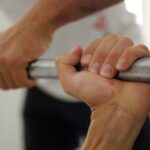Push-ups have long been a staple in bodyweight training, but can they truly replace traditional weightlifting for building a massive chest? While bench presses and dumbbell presses are often viewed as superior for chest hypertrophy, push-ups can be an effective alternative when performed correctly and progressively overloaded. This article will analyze bodyweight training, explore different push-up variations, and discuss how to make them progressively harder for continuous muscle growth.
The Science Behind Push-Ups and Muscle Growth
Muscle growth, or hypertrophy, occurs when muscles are exposed to progressive tension, metabolic stress, and muscle damage. While traditional weight training achieves this through increasing weights, push-ups can be adapted using progressive overload techniques to stimulate similar chest development.
Push-ups primarily target the pectoralis major, anterior deltoids, and triceps, while also engaging the core and stabilizing muscles. However, for significant muscle gains, they must be structured with proper variation and progression.
8 Different Push-Up Variations for Chest Growth
One of the biggest misconceptions about push-ups is that they’re too easy. The truth is, different push-up variations can significantly increase intensity and target the chest in unique ways:
1. Standard Push-Up
- Targets the overall chest, shoulders, and triceps.
- Best for endurance and foundational strength.
2. Wide Grip Push-Up
- Places more emphasis on the outer chest.
- Reduces triceps involvement, making it more chest-dominant.
3. Decline Push-Up
- Targets the upper chest similar to an incline bench press.
- Increases difficulty due to more body weight being shifted forward.
4. Diamond (Close-Grip) Push-Up
- Focuses on the inner chest and triceps.
- Engages the anterior deltoids more than standard push-ups.
5. Archer Push-Up
- A unilateral variation that increases range of motion.
- Builds strength and muscle balance between arms.
6. One-Arm Push-Up
- Maximizes resistance on one side of the chest.
- Requires significant core and shoulder stability.
7. Plyometric (Explosive) Push-Ups
- Enhances fast-twitch muscle fibers for power and explosiveness.
- Can be done with claps or explosive movements to increase intensity.
8. Weighted Push-Ups
- Adds external resistance via a weighted vest or backpack.
- Mimics the progressive overload principle of traditional weightlifting.
How to Make Push-Ups Progressively Harder
To build a massive chest with push-ups, progressive overload must be implemented. Here are some key ways to make push-ups harder over time:
1. Increase Repetitions and Sets
- Start with 3-4 sets of 10-15 reps and gradually increase reps.
- Use slow eccentric movements (lowering phase) to increase time under tension.
2. Elevate the Feet
- Decline push-ups shift more weight onto the upper body, increasing difficulty.
3. Use Resistance (Weighted Vest or Backpack)
- A weighted vest can simulate the progressive resistance of bench pressing.
- Adding plates on the back also increases load.
4. Perform Explosive Variations
- Plyometric push-ups engage fast-twitch muscle fibers, leading to better hypertrophy and power development.
5. Decrease Stability (Ring or TRX Push-Ups)
- Using gymnastic rings or suspension trainers forces more muscle activation.
- Increases stabilization demands, leading to greater muscle engagement.
6. Slow Down the Tempo (Time Under Tension)
- Slow eccentric (lowering) movements can increase muscle fatigue.
- Example: Lower for 4-5 seconds and explode up.
Comparing Push-Ups vs. Bench Press for Chest Growth
While push-ups can build a well-developed chest, they do have limitations compared to heavy bench pressing:
| Factor | Push-Ups | Bench Press |
|---|---|---|
| Resistance | Limited by bodyweight (unless weighted) | Can be easily increased |
| Chest Activation | High with proper form | Even higher under heavy loads |
| Triceps Involvement | Moderate to High | High |
| Progressive Overload | Achievable through variations & added weight | Easily done with added plates |
| Core Engagement | High | Lower |
| Accessibility | Can be done anywhere | Requires gym equipment |
For maximum chest hypertrophy, a combination of push-ups and weight training is ideal. However, if weights are not an option, progressively loaded push-ups can still develop an impressive chest.
Sample Push-Up Progression Routine for Chest Growth
This 4-week push-up progression plan will help you continuously challenge your muscles:
Week 1-2: Foundational Strength
- Standard Push-Ups – 3 sets of 12-15 reps
- Wide Grip Push-Ups – 3 sets of 10 reps
- Decline Push-Ups – 3 sets of 10 reps
Week 3-4: Increased Difficulty
- Archer Push-Ups – 3 sets of 8 reps per arm
- Weighted Push-Ups – 3 sets of 10 reps
- Explosive Push-Ups – 3 sets of 8 reps
Note: Adjust repetitions based on personal strength level.
Can You Build a Massive Chest Without Weights?
The short answer is yes—but with caveats. While push-ups alone can build an impressive chest, their effectiveness depends on progressive overload, variation, and execution. Advanced variations like weighted push-ups, decline push-ups, and explosive movements can replicate the benefits of traditional bench pressing.
If you have access to a gym, combining push-ups with bench press and dumbbell work will yield the best results. But if you’re limited to bodyweight training, a structured push-up progression plan can still develop a strong, well-defined chest over time.
Discover more from IncogNatty
Subscribe to get the latest posts sent to your email.









